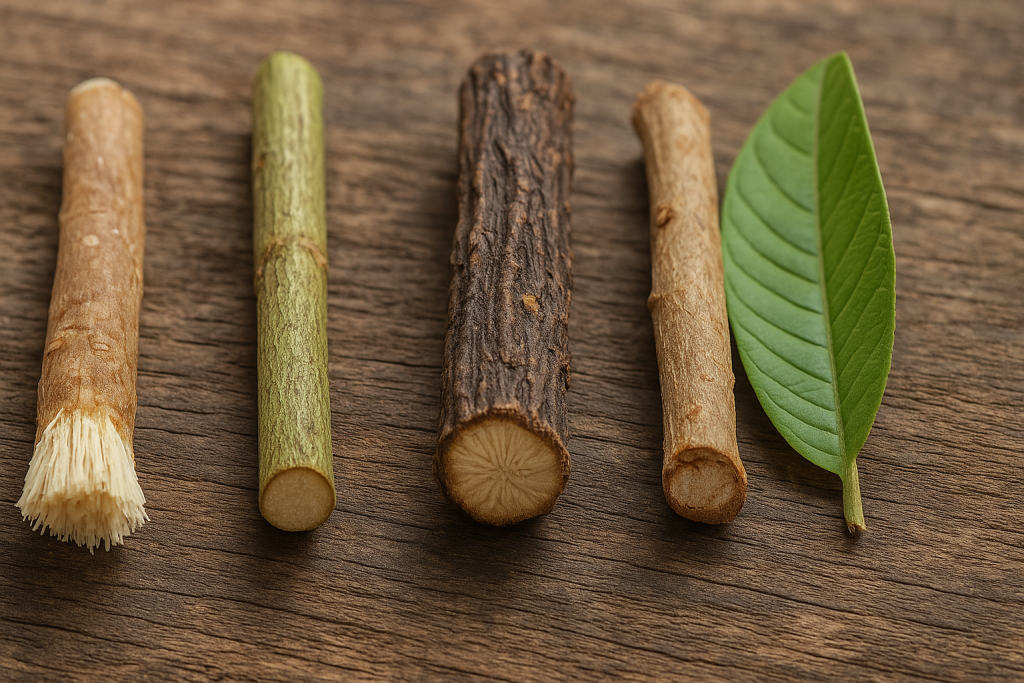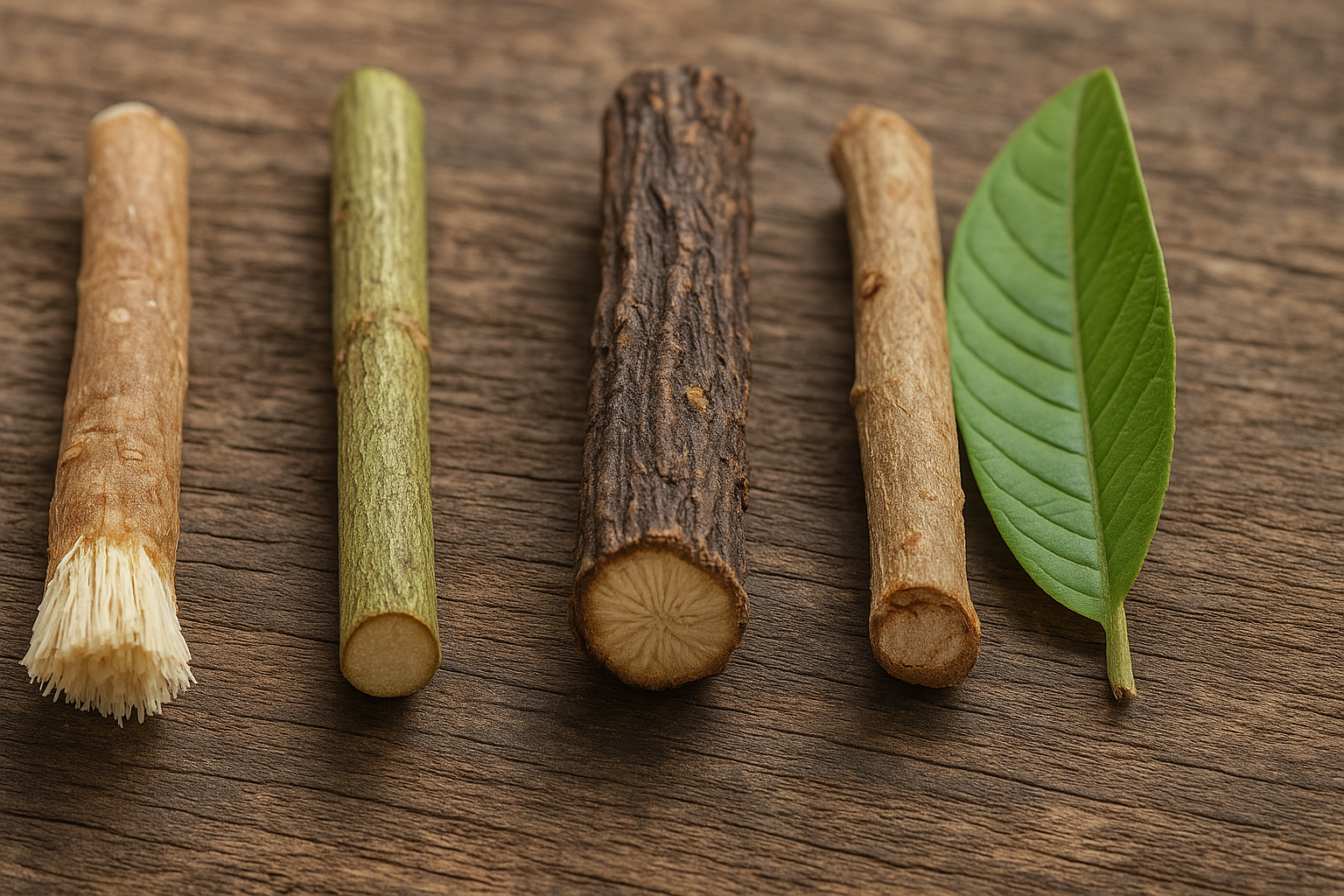
Could your oral care routine be missing something ancient?
If your toothbrush could talk, it might admit it’s a bit outclassed—especially by a humble twig.
Across the UK and beyond, there’s growing interest in natural, chemical-free alternatives to everyday health products. From herbal teas replacing synthetic sleep aids to beeswax wraps nudging clingfilm aside—green is not just a colour, it’s a commitment. And oral care is no exception.
In this post, we’ll explore four age-old dental allies:
- Miswak (Salvadora persica)
- Neem (Azadirachta indica)
- Licorice root (Glycyrrhiza glabra)
- Guava (Psidium guajava)
Used across Africa, Asia, and Latin America for thousands of years, these sticks are more than cultural curios—they’re science-backed dental champions with real-world benefits for modern mouths.
Did you know…
In one clinical trial, Miswak reduced plaque more effectively than a standard toothbrush⁽¹⁾.
The Problem with Conventional Oral Care
Let’s take a peek inside your toothpaste tube.
Modern oral care products often contain:
- Sodium fluoride – effective against cavities, but excessive use in children can cause dental fluorosis⁽²⁾.
- Sodium lauryl sulfate (SLS) – a foaming agent that may irritate the oral lining⁽³⁾.
- Triclosan and chlorhexidine – antiseptics that can lead to taste changes, staining, and microbial imbalance⁽⁴⁾.
Even popular mouthwashes like Corsodyl® (chlorhexidine-based) have been shown to:
- Stain teeth with prolonged use
- Interfere with taste receptors
- Suppress beneficial oral bacteria⁽⁵⁾
Myth-busting fact:
Chlorhexidine mouthwash should not be used immediately after brushing, as it may interact negatively with toothpaste fluoride⁽⁶⁾.
That’s why many UK dentists recommend gentler care, especially for children, those with gum sensitivity, or anyone interested in preserving the oral microbiome.
Miswak – The 5,000-Year-Old Wonder Stick
🌿 Salvadora persica
Miswak—also called siwak—is derived from the Salvadora persica tree and holds a special place in Islamic hygiene traditions. But its appeal is universal: compact, effective, and totally natural.
🔬 What’s inside:
- Natural fluoride – helps remineralise enamel
- Salvadorine & trimethylamine – antimicrobial compounds
- Silica – scrubs plaque away gently
- Tannins – tighten gum tissue
- Essential oils – freshen breath
“Chewing Miswak is like brushing with a toothbrush dipped in herbal mouthwash.”
🧪 Scientific Evidence
A study in the Journal of Ethnopharmacology found Miswak to be as effective as toothbrushes, and in some cases, superior in reducing plaque and gingivitis⁽¹⁾. Another review by WHO concluded it’s a safe and effective tool when used properly⁽⁷⁾.
STAT:
Miswak use led to a 21% reduction in gingivitis scores in just 2 weeks⁽¹⁾.
🪥 How to Use Miswak:
- Peel 1cm of bark
- Chew the tip to form soft bristles
- Brush teeth with short, vertical strokes
- Cut the used tip every few days
In the UK, Miswak is available in halal shops, herbal stores, or online retailers. Look for fresh, non-dried sticks.
⚠️ Cautions:
- Don’t scrub too hard—Miswak is abrasive
- Store in a breathable pouch to prevent mould
- Replace regularly (every 2–3 weeks)
Neem – The Ayurvedic Healer
🌿 Azadirachta indica
Native to India, the neem tree has long been revered in Ayurveda for its blood-purifying and anti-infective properties. Its twigs have been used as chewing sticks, particularly in rural areas where toothbrushes were rare—but oral hygiene was excellent.
💚 Natural Benefits:
- Azadirachtin and nimbin – antibacterial
- Triterpenoids – anti-inflammatory
- Flavonoids and tannins – antioxidant and gum-toning
Study highlight:
A neem mouth rinse showed comparable gum healing to chlorhexidine, with fewer side effects⁽⁸⁾.
How to Use Neem:
- Choose fresh green twigs
- Peel and chew one end to create a brush
- Rinse mouth with cooled neem-leaf tea
Tip: Neem twigs are available online or from South Asian herbal stores in cities like Birmingham or Leicester.
Licorice Root – The Soothing Sweet Stick
🌿 Glycyrrhiza glabra
Used traditionally in Chinese, Greek, and Unani medicine, licorice root is not just a sweet treat—it’s a powerful oral remedy. The dried root can be chewed as a gentle cleanser or brewed as tea for inflamed gums.
🍭 Active Compounds:
- Glycyrrhizin – antiviral and antibacterial
- Liquiritin – anti-inflammatory
- Saponins – mild foaming action
- Natural sweetness – helps mask bitterness
Clinical trial:
A 2011 study found licorice extract reduced plaque bacteria like Streptococcus mutans in just 3 days⁽⁹⁾.
Did you know…
Licorice is effective against oral Candida infections without harming beneficial bacteria⁽¹⁰⁾.
How to Use Licorice:
- Chew dried sticks (available at UK herbal shops)
- Sip as a tea (steep for 10 mins)
- Use as a mouth rinse after cooling
⚠️ Caution:
Avoid high doses if you have high blood pressure, are pregnant, or are on heart medication. Always choose whole root, not candy.
Guava – The Leafy Defender
🌿 Psidium guajava
Guava leaves and bark have long been used in Filipino, Caribbean, and African traditions to combat bad breath, soothe gums, and heal ulcers.
🍃 Phytochemicals:
- Quercetin & flavonoids – antioxidant
- Tannins – firm up loose gum tissue
- Vitamin C – promotes collagen and gum repair
2020 study:
A guava-leaf mouth rinse reduced gingivitis similarly to Corsodyl, with no side effects⁽¹¹⁾.
Lab study:
Guava extract neutralised oral bacteria in just 60 seconds⁽¹²⁾.
How to Use Guava:
- Chew freshly washed leaves
- Boil 10 leaves in 250ml of water
- Cool and swish for 30 seconds, 2x/day
Modern Science Meets Ancient Wisdom
Let’s break it down:
| 🌿 Chewing Stick | 🔬 Proven Effects | 🧴 Modern Match |
|---|---|---|
| Miswak | Reduces plaque & gingivitis, kills oral pathogens | Fluoride toothpaste |
| Neem | Antibacterial, gum repair | Antiseptic toothpaste |
| Licorice | Antifungal, soothes ulcers | Medicated mouthwash |
| Guava | Reduces gum swelling, breath freshening | Corsodyl® rinse |
Conclusion: Bring Nature Back Into Your Bathroom Cup
You don’t need to bin your toothbrush—but why not team it up with something that’s stood the test of time?
With Miswak, Neem, Licorice, and Guava, you’re not just cleaning teeth—you’re nourishing gums, restoring balance, and skipping the synthetic overload.
Start with one. See how your mouth feels. You might just find yourself hooked on herbal.
👉 Want to go even further?
Try our DIY guide to making your own herbal toothpaste from scratch:
➡️ Explore Our Natural Toothpaste Recipe
📥 Also, download your free Wellness Starter Guide from Quidian Naturals—packed with plant-powered swaps, beginner-friendly tips, and holistic wisdom.
References
- Al-Otaibi, M., et al. (2003). Comparison of the effectiveness of chewing sticks and toothbrushes on plaque removal and gingival health. Oral Health & Preventive Dentistry, 1(2), 105–112.
- Cochrane Oral Health Group. (2019). Fluoride toothpastes of different concentrations for preventing dental caries. Cochrane Database of Systematic Reviews.
- Herlofson, B., & Barkvoll, P. (1994). The effect of two toothpastes on the frequency of recurrent aphthous ulcers. Acta Odontologica Scandinavica, 52(5), 257–259.
- Thomas, L. (2004). Triclosan: What the research says. British Dental Journal, 196(9), 479–482.
- Lorenz, K., et al. (2008). Side effects of chlorhexidine mouthwash. Journal of Clinical Periodontology, 35(5), 386–392.
- Addy, M., & Moran, J. (1995). Interaction between chlorhexidine and toothpaste detergents. Journal of Clinical Periodontology, 22(4), 270–272.
- World Health Organization (WHO). (1987). Oral Health Surveys: Basic Methods. WHO Report, Geneva.
- Chava, V. K., et al. (2012). Efficacy of neem mouth rinse compared to chlorhexidine. Journal of Indian Society of Periodontology, 16(4), 543–548.
- Das, S. N., et al. (2011). Efficacy of licorice root extracts in oral care. Oral Health & Preventive Dentistry, 9(1), 87–92.
- Chen, H., et al. (2010). Antifungal properties of licorice extract against Candida albicans. Journal of Medical Microbiology, 59(Pt 7), 843–846.
- Mahasneh, S. A., et al. (2020). Comparative study of guava mouth rinse and chlorhexidine. Journal of Oral Health and Community Dentistry, 14(1), 20–24.
- Kamatou, G. P. P., et al. (2017). In vitro antimicrobial effects of Psidium guajava leaf extracts. Pharmaceutical Biology, 55(1), 1109–1115.
